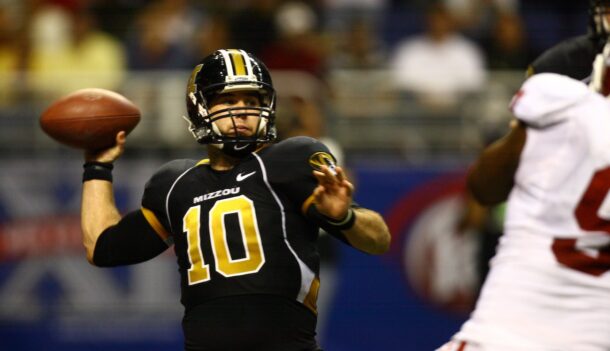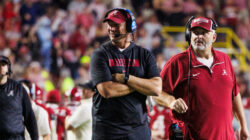
Kentucky football: 5 things that will define the Wildcats’ offense in 2021
By Joe Cox
Published:
Can Kentucky keep the good (5 consecutive bowl appearances and 20 SEC wins over the last 5 years) and improve upon the not-so-good (a passing game that finished last in the SEC by a sizeable margin in 2019 and 2020)?
That’s the task ahead of Mark Stoops, who trails only Alabama’s Nick Saban in length of tenure among active SEC head coaches. While 2020 ended up shy of Kentucky’s expectations, there’s plenty of reason to be optimistic about the overall direction of the program.
Kentucky’s offensive line and stable of running backs have been among the SEC’s best since 2016, when Stoops and a plucky true freshman named Benny Snell seemed to reverse Kentucky’s historical fortunes. Given that UK’s defense has been solid, the onus for improvement is on the offense, complete with new offensive coordinator Liam Coen, formerly of the Los Angeles Rams. Old coordinator Eddie Gran is gone and so is former starting QB Terry Wilson, who transferred to New Mexico.
Can Kentucky continue to pound the football but incorporate in a reasonable passing offense? Will doing so be enough to lift the Wildcats from the middle of the SEC pack (2019, 2020) back to the upper echelon, where they finished 2018?
Here are 5 matters that will largely tell the story of UK’s 2021 offense, and an early guess as to how it all might shake down.
1. What impact will the passing game have?
This is the big question. Eddie Gran didn’t leave town and Liam Coen didn’t come in to keep things as they were. The good news is that Coen can’t really help but have a positive impact. Kentucky passed for 122 yards per game in 2020. The 13th place team in the SEC, South Carolina, passed for 187. Everybody else had 204 passing yards per game or more.
Because of the struggles in passing, Kentucky had trouble scoring (11th in SEC), gaining yardage (last in the SEC, 318 yards per game), and moving the chains (9th in the SEC in 3rd-down conversion rate, 11th in 4th-down conversion rate, despite the 3rd-ranked rushing attack in the league).
Let’s be conservative here and say that Kentucky goes from 14th in the SEC in passing to perhaps 9th. Based off last year’s numbers, that would be in the vicinity of 220-240 passing yards per game. Adding on roughly another 100 yards per game in offense would jump Kentucky to around 7th in total offense. It would no doubt create a similar leap in scoring from around 22 points per game to a number nearer to 30 points per game, and could well be the difference in going 4-6 in the SEC and perhaps 5-3 in 2021.
All gas no breaks ?? #ForTheTeam ?? pic.twitter.com/AY2DcP4z67
— Kentucky Football (@UKFootball) April 17, 2021
2. Who will lead the passing game?
Coen’s connections with the Rams aside, this offense won’t just run itself. UK quarterback Terry Wilson, often successful and sometimes beleaguered, has moved on and the offense will be in new hands in 2021. Penn State transfer Will Levis is regarded as a prohibitive favorite to win the job in the fall. He’ll have 3 years of eligibility, and while he was used mostly as a mobile QB at Penn State, Levin has shown the arm skills to make plays. But Levis wasn’t on campus for the spring, and so he will have some ground to make up.
Penn State QB @will_levis putting in work! @PennStateFball pic.twitter.com/4z46bQAQPa
— M2 QB Academy (@M2_QBacademy) January 15, 2021
Kentucky didn’t have a spring game or open practices, so reliable information about the duel between former Auburn transfer Joey Gatewood and freshman Beau Allen is sparse. Both saw some time last season, with Gatewood filling in for Wilson as the starter against Georgia and delivering one of the sleepiest offensive performances imaginable. On the season, Gatewood was 17-for-35 passing for 109 yards and an interception. Allen was 3-for-7 for 40 yards. Early speculation was that Allen might be a better fit for Coen’s offense than Gatewood, who is more of a dual-threat QB. But coaches were quietly positive about both QBs, and a few camp whispers suggested that Gatewood had the better spring.
Even if Levis does (eventually) win the job, Kentucky has relied on its backup QBs in several recent seasons (2016, when Stephen Johnson supplanted an injured Drew Barker after Week 2 and 2019, when Lynn Bowden became the full-time emergency QB after season-ending injury to Wilson and serious injury to backup Sawyer Smith). The second-place race will be only slightly less significant than the battle for the starting job.
3. Where’s Wan’Dale?
Nebraska transfer Wan’Dale Robinson, who once committed to Kentucky only to decommit for the perceived greener pastures of Lincoln, could be in the middle of a big party this fall. Once Kentucky determines who the trigger man will be for the offense, somebody has to catch some passes. The Wildcats return senior Josh Ali, whose 54 catches in 2020 were more than 3 times those of the next-highest total on the UK team. And now, they’ve got Wan’Dale.
Robinson caught 91 passes for 904 yards in 2 years at Nebraska. The Huskers used him sometimes at running back, and Robinson rushed for another 580 yards. There should be no question about his position in Lexington. Robinson figures to use his explosive speed to make plays in the slot, and could well fulfill a Lynn Bowden-like role, for those who can remember Bowden as a wide receiver before his option QB success in 2019.
If Ali can manage another 50+ catch season and Robinson can do likewise, Kentucky is probably an outside receiver from a dangerous position group. Frosh Christian Lewis is one possibility, and returning veteran Isaiah Epps has the size and skills, but has to stay healthy and produce on the field. Tight ends Keaton Upshaw and Justin Rigg have shown some pass-catching ability as well, but depth outside the top handful of players will be worth keeping an eye on.
4. How to use the running backs?
Kentucky split snaps for running backs in 2020 between senior A.J. Rose and sophomores Chris Rodriguez and Kavosiey Smoke. But Smoke struggled with injuries and consistency, and Rose won’t be back in 2021. So Rodriguez (119 carries, 785 yards, 11 TDs in 2020) is the pre-emptive first man up. Will Coen find sufficient snaps for Smoke? Returnees JuTahn McClain, Travis Tisdale and former linebacker Terrence Davis could all shine, as might incoming standout La’Vell Wright.
One interesting wrinkle is that Coen planned to also involve Rodriguez in the passing game. As Rodriguez caught just a single pass last season, adding pass-catching to his job duties stands to add another dimension for the bullish running back.
Whoever plays and however they are used, Kentucky will have its hands full trying to replicate 2020’s totals of 197 yards per game on the ground. For that matter, the Wildcats might be unlikely to equal 2020’s average of 40 rushing attempts per game. But if Kentucky can rush, say, 30-35 times for 150-175 yards and use the extra snaps to balance the passing game, it might be for the best.
5. Who plays up front as the line gets shuffled?
Landon Young and Drake Jackson are NFL-bound, and while massive tackle Darian Kinnard chose to return, Kentucky does have a couple of spots to fill. Jackson’s center spot presents the possibility of shuffling returning starters Luke Fortner or Kenneth Horsey. Massive JUCO lineman Jeremy Flax is likely to be in the battle at tackle. True frosh Jager Burton is just too good to not see significant time.
In any case, Kentucky has big shoes to fill on the line, and figuring out who and where will be pivotal for the offense. Offensive line coach John Schlarman was tragically lost to cancer in 2020, but the blue-collar group he had a large role in assembling will likely keep his gritty approach foremost in 2021.
Joe Cox is a columnist for Saturday Down South. He has also written or assisted in writing five books, and his most recent, Almost Perfect (a study of baseball pitchers’ near-miss attempts at perfect games), is available on Amazon or at many local bookstores.







